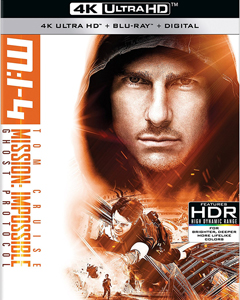May is the month of “M:I,” as we look back at the six “Mission: Impossible” films from May 2-10. Next up is the fourth entry, “Mission: Impossible – Ghost Protocol” (2011):
From solid to spectacular
The “Mission: Impossible” series goes from a solid spy/action saga to a spectacular one with director Brad Bird’s “Mission: Impossible – Ghost Protocol.” This fourth entry blends a good story (a trait of the first film) with the action emphasis (traits of the subsequent films).
For the second straight film, “Alias” veterans pen the screenplay; I dig how Josh Appelbaum and Andre Nemec give us a globe-spanning yarn that takes us to Moscow, Dubai and Mumbai.

“Mission: Impossible – Ghost Protocol” (2011)
Director: Brad Bird
Writers: Bruce Geller, Josh Appelbaum, André Nemec
Stars: Tom Cruise, Jeremy Renner, Simon Pegg
As animation master Bird leaves no doubt he can handle live-action, the centerpiece sequence finds Ethan Hunt (Tom Cruise, striking a balance between doing-his-job and this-is-personal) free-climbing at the 130th story of a Dubai skyscraper, and the vertigo effect is such that you might want to watch it on the smallest screen possible just so you don’t lose your s***. It makes the Shanghai rooftop swing in “M:I 3” look like a kiddie playground.
It’s remarkable how Hunt effortlessly adjusts to a new group dynamic each time; it’s as if Cruise has chemistry with everyone. Simon Pegg’s Benji is back from part three but has a bigger role here as a field agent. I enjoy the duo’s wry humor dynamic in the opening prison-escape sequence: Ethan gestures to the cameras to get Benji to open additional cell doors and casually waits until he does it.
Still, not everything is old hat for Ethan. The tension of the skyscraper climb shows on Cruise’s face as if the actor is genuinely reeling from the insane stunt work.
Like classier Expendables
Rounding out the disavowed ex-IMF crew (basically, our heroes are classier Expendables) is Jane, played by Paula Patton, who pulls off the “seduce the rich bad guy” sequence in a refreshingly direct way. (“Slumdog Millionaire’s” Anil Kapoor amusingly plays the wealthy Indian.)
It’s surprising that this is by far the biggest credit for Patton, who shows effortless action chops. And the final member is Brandt, played by Jeremy Renner, who finds room for a second action franchise along with “The Avengers.”
Supposedly a mere IMF analyst, Brandt’s mysterious background is peppered into the narrative. So is the question of what happened to Hunt’s wife, Julia (Michelle Monaghan), who we met in “M:I 3.” Some franchises would’ve left it at “Oh, they broke up between films,” and we’d have to accept the filmic convention. I like how “Ghost Protocol” goes deeper into what happened between films – not to the point where I feel like I missed an excellent part 3.5, but to the point where we feel the emotional impact on Ethan.

“Ghost Protocol” has a blast with near-future sci-fi technology even though the famous masks are barely used here. Much to Benji’s dismay, the 3D printer breaks down while making masks of the baddies the team intends to impersonate. It forces Hunt, Brandt, Benji and Jane to improvise their way through intense negotiations with bad guys that include a document scanner in Brandt’s contact lens.
The tech highlight, though, is a computer drop screen that can be placed in such a way that a guard believes he’s seeing an empty hallway. Ethan and Benji move it forward along the hallway in the Kremlin until they can access the room they want.
Cold War fears are hot again
The previous film uses an unexplained end-of-the-world maguffin, but “Ghost Protocol” directly leans into the old Cold War fears, resurrecting them without being stale. The villain, Hendricks (Michael Nyqvist), plans to start a nuclear war between the USA and Russia in the same manner as Skynet from “Terminator.”
The goal is mundane, but his philosophy is fascinating: He believes peace will be achieved in the wake of the war because everyone on Earth will be hurt equally. Hendricks would get along well with “Watchmen’s” Dr. Manhattan.
My one small quibble with the screenplay is that the USA – as explained by Hunt’s handler (Tom Wilkinson) – will not inform the Russians that Hendricks, not Hunt’s team, bombed the Kremlin. The handler’s explanation is that “They won’t believe us anyway.”
But what could it hurt to inform them of the truth? Instead, Hunt has to deal with a side annoyance of a Russian agent (Vladimir Mashkov’s Sidorev) being on his tail, “Fugitive” style. I dislike innocent-man-on-the-run tales, but at least this one doesn’t intrude too much on the main plot and it wraps up in satisfying fashion.
Overall, this is a tight, thrilling action masterpiece. It allows us to ponder the plot’s intricacies and observe highly skilled agents come together as a team, all while taking a lavish virtual vacation around the Eastern Hemisphere.
Schedule of reviews
Saturday, May 2: “Mission: Impossible” (1996)
Sunday, May 3: “Mission: Impossible II” (2000)
Wednesday, May 6: “Mission: Impossible III” (2006)
Thursday, May 7: “Mission: Impossible — Ghost Protocol” (2011)
Saturday, May 9: “Mission: Impossible — Rogue Nation” (2015)
Sunday, May 10: “Mission: Impossible – Fallout” (2018)
Also of interest: Shaune’s rankings of the six “Mission: Impossible” films

